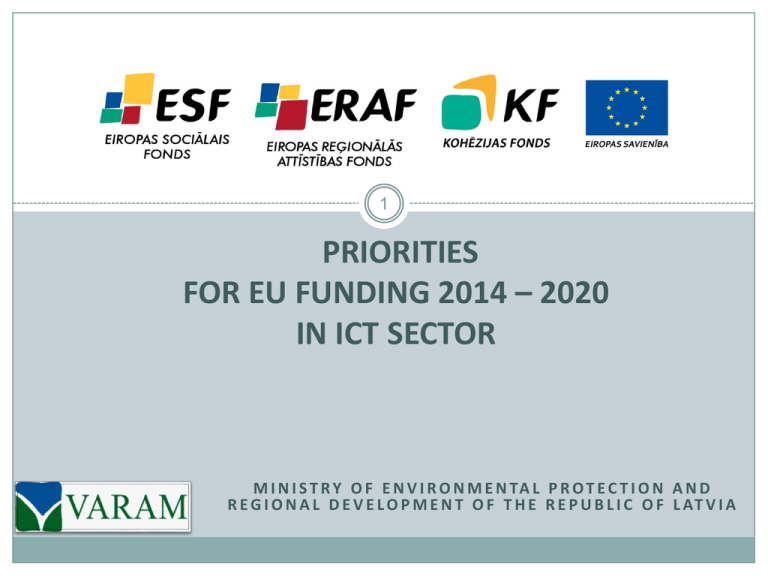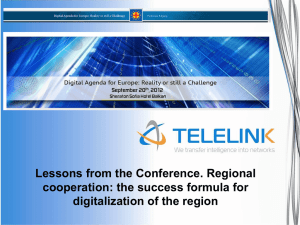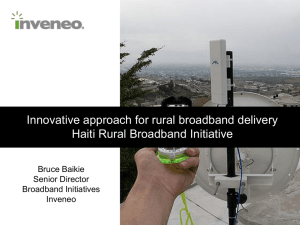Information Society Development Guidelines 2014-2020
advertisement

1 PRIORITIES FOR EU FUNDING 2014 – 2020 IN ICT SECTOR M I N I S T R Y O F E N V I R O N M E N TA L P R O T E C T I O N A N D R E G I O N A L D E V E L O P M E N T O F T H E R E P U B L I C O F L AT V I A Strategies and policy planning documents 2 Complies with the priority’s “Smart, sustainable and inclusive growth” flagship initiative “Digital Agenda for Europe” of the strategic document Europe 2020: strategy for smart, sustainable and inclusive growth; Complies with priority “Innovative government and public participation” and its long-term action direction “E-government and Public innovation” of the Sustainable development strategy of Latvia until 2030; Complies with the priority “Growth supporting areas” and its action area “Availability of services for creating more equal opportunities for employment and living conditions” of National Development Plan 2014-2020; Complies with the action area of the National Reform Program of Latvia “EU 2020” “Rebalanced economic development, promoting development of tradable sectors and raising productivity” and its action “Development of information and communication technologies (ICT) and implementation of Single Market”; Complies with the priorities “Innovative and competitive business and research environment” and “Modern infrastructure for growth and jobs” of the Position of the Commission Services on the development of Partnership Agreement and programmes in Latvia for the period 2014-2020 Current situation 3 Catalogue of Public services *Including 270 e-services from current EU funding period (EUR 137,94 million) Strategic view of ICT activities 4 Thematic objective: (2) enhancing access to and use and quality of ICT Investment priority: (b) developing ICT products and services, e-commerce and enhancing demand for ICT; (c) strengthening ICT applications for e-government, e-learning, eInclusion and e-health Strategic view of ICT activities 5 ICT governance ICT Organizational Governance Model of Public Administration (approved on 19 February 2013) ICT strategy Information Society Development Guidelines ICT action plans E-Government Development Plan (approved on 25 May 2011) E-Skills Development Plan (approved on 18 May 2011) Information Society Development Guidelines 2014-2020 6 Target: Ensuring that everyone has a chance to use benefits from ICT, develop knowledge-based economics, and improve general quality of life by giving an input in national productivity, efficiency of public administration and competitiveness of businesses Action areas Wide access Modern and to effective Digital skills information public and literacy society adminisinfrastration tructure Cross-border E-services co-operation Competitive ICT research for Digital and digital business and Single content for environment innovations Market society Trust and security Strategic view of ICT activities 7 ICT Governance, Strategy, Policy Development of eservices, enhancing availability and use of public services Business proceses Technology Open and interoperable public data infrastructure People Improvement of e-skills Next Generation Network and Broadband Infrastructure Strategic view of ICT activities Activity Problem targeted Objectives Development of e-services, enhancing availability and use of public services •only 21% of services are available electronically •overall level of usage of e-services remains relatively low compared to traditional service delivery methods •to ensure the incorporation of Latvia in the European Single 8 Market •to ensure the availability of public services in the most convenient way for different society groups, increasing the economic benefit for a public service client by reducing the administrative burden on society and enhancing economic potential based on public sector information re-use •to adapt the national services to ensure requirement of establishing at least 5 cross-border e-services in the upcoming years (Digital Agenda for Europe Open and interoperable public data infrastructure •public administration exploits decentralized information systems developed in different time periods, with no use of common IT standards, methods and technology standards •the lack of appropriate open data infrastructure is an obstacle to put into effect economic and social potential of public administration data in order to ensure implementation of open data initiatives. Improvement of e-skills •gap between e-service availability and usage •low awareness of e-government services •to establish open, interoperable and optimally organized public data governance, facilitating general public’s communication with public administration, automatising governance processes and letting to achieve more with less investments, thus drawing positive effect on economic sector •to improve general public’s knowledge about e-services and eopportunities provided by the public administration •to raise ICT competences of state and municipal management level workers in order to effectively organize delivery of services Proposed activities for 2014-2020: Development of e-services, enhancing availability and use of public services 9 Target group: individuals, businesses, public authorities, local authorities, non governmental organizations Type of support: transformation/re-design and cost-effective electronization of public service delivery processes in all public administration sectors, thus promoting cross-sectoral cooperation and provision of One-Stop Agency and Give Data Once principles both at national level and ensuring availability of services abroad; development of cross border e-services within the framework and tasks of the Digital Agenda for Europe; participation in the cross-border cooperation projects ensuring the full-fledged implementation of the Directive 2006/123/EK on services in the internal market and continuing the incorporation of Latvia in the European Single Market; adaptation of the services for cooperation in the European Single Market by establishing solutions to make e-services available in other EU languages Output indicators: 775 developed or modernized e-services ERDF funding: 110,49 million EUR National co-financing: 19,49 million EUR Proposed activities for 2014-2020: Open and interoperable public data infrastructure 10 Target group: public authorities, local authorities, individuals, businesses Type of support: development of centralized ICT platforms and information systems providing modernization of public administration governance processes and efficiency of resources by developing open data infrastructure and interoperability solutions for data exchange with European Solutions Output indicators: 23 Centralized information systems’ platforms ERDF funding: 61,22 million EUR National co-financing: 10,8 million EUR Proposed activities for 2014-2020: Improvement of e-skills 11 Target group: individuals, businesses, public authorities, local authorities Type of support: different forms and levels of activities (e.g. seminars, educational trainings) targeted at improvement of people’s knowledge about public e-services and e-opportunities offers and their utilization, especially focused on people living in rural areas educational trainings for state and municipal workers so they can strengthen their efficiency and productivity through effective organization of service delivery as well as they are able to support and educate clients on use of public e-services Output indicators: 256 000 individuals who have raised their digital competency ERDF funding: 4,88 million EUR National co-financing: 0,86 million EUR Expected result indicators 12 Ministry of Transport of the Republic of Latvia Department of Communications Broadband network infrastructure development in Latvia Europe 2020 and Digital Agenda goals for broadband All Europeans should have access to higher internet speeds of above 30 Mbps; 50% or more of European households subscribe to internet connections above 100 Mbps; List of Actions Action 46: Member States to develop national broadband plans; Action 47: Member States to facilitate broadband investment; Action 48: Use structural funds to finance the roll-out of high-speed networks; Action 49: Implementing the European Radio Spectrum Policy Programme in Member States. 14 National Legal Basis in Latvia Sustainable Development Strategy of Latvia until 2030; National Development Plan 2014 – 2020; Electronic Communication Sector Guidelines 2011 – 2016; Concept “Next Generation Access Network Development 2013 – 2020” 15 Weaknesses Digital gap between urban and rural areas 16 Weaknesses • There are no operators, intended to create access points to optical network in 71.2% of Latvia’s territorial units (in county municipalities); • Operators have no plans to develop the optical subscribe lines in the territories with middle and low economic interests; • The use of currently available radio spectrum, that can deliver to the end users internet access speeds defined in the Digital Agenda is not economic profitable in sparsely populated territories • Low purchasing power of inhabitants in rural areas. 17 Broadband penetration and Internet usage Basic and high-speed (30 Mbps and above) penetration, July 2012 (Source: COCOM) According to Central Statistical Bureau of Latvia, there was 62,5% of inhabitants in Latvia, regularly using Internet in 2010, 66,2% in 2011 and 70,3% in 2012. 18 Development of broadband (NGN) Objectives: State aided development of the broadband infrastructure - second phase of project “Next Generation Network for rural areas”; Possible solutions: Within the framework of Optical Network State Aid Program, provide EU funding; Not to provide funding. 19 Development of broadband (NGN) Objective: Development of the broadband infrastructure - second phase of project “Next Generation Network for rural areas”: Selected solution: Within the framework of Optical Network State Aid Program, provide EU funding; Benefits: The broadband access infrastructure will offer open wholesale access basis to third-party operators, who will be able to add their access infrastructures (i.e. the last mile network segment) and deliver broadband services to end-users (consumers, businesses and public institutions). By 2015 the first phase of the NGN project will ensure connection for approximately 165 points (1900 – 2000 km of fibre lines). By 2018 the NGN project foresees totally setting up 500 connection points to NGN (approximately 7000 km of fibre lines). Funding: EU funds 28,45 million EUR; National co-finance 28,45 million EUR Result of activity Planned achievable 2011 indicator 2016 2020 Established broadband fibre network in all teritory Proportion of territorial units, where wholesale access to fibre network is available 54.9 % 100% 20 28.8 % Development of broadband (last mile) Objectives: State aided development of the broadband infrastructure - establishment of last mile connections. Possible solutions: To establish last mile connections in sparsely populated and low economic activity regions; Not to establish connections. 21 Development of broadband (last mile) Objective: Development of the broadband infrastructure - establishment of last mile connections: Selected solution: To establish last mile connections in sparsely populated and low economic activity regions; Benefits: Electronic communications operators will have opportunity to provide Internet access services to end users in rural areas. End-users will have the opportunity to choose the retail operator, the services and the last mile technology according to their needs. Funding: EU funds 22,75 million EUR; National co-finance 34,14 million EUR Result of activity Planned achievable 2011 indicator 2016 2020 Increased number of subscribers, who has Internet access speed of above 30 Mbit/s The number of households subscribed to Internet access services of above 30 Mbit/s - 40 000 - 22 Coherence and synergy between envisaged State Aid programmes • State Aid for the establishment of the last mile connections will be based on the study that will take into account: – impact of the project “Next Generation Network for rural areas”; – public auction of the 800 MHz band. • Roll - out of high speed fibre networks as well as allocation of rights of use of 800 MHz band will contribute to the development of last mile: – Electronic communication operators will have opportunity to connect their infrastructure to the high speed fibre networks in order improve internet access services to the existing end-users – 800 MHz band is suitable to cover sparsely populated areas and provide high speed internet access to end-users 23 Coherence and possible synergy with other relevant activities The activities “Next-generation network in rural areas” and “Development of the broadband infrastructure – the establishment of last mile connection” are complementary to the 2014-2020 planning period activities of the Ministry of Environmental Protection and Regional Development “Development of e-services, enhancing availability and use of public services”, “Open and interoperable public data infrastructure” and “Improvement of e-skills”. Creation of fast and ultra-fast data transmission network and availability of it in the whole territory of Latvia will lay the ground for sustainable development of e-services and digital content. 24 Thank you for your attention! 25







